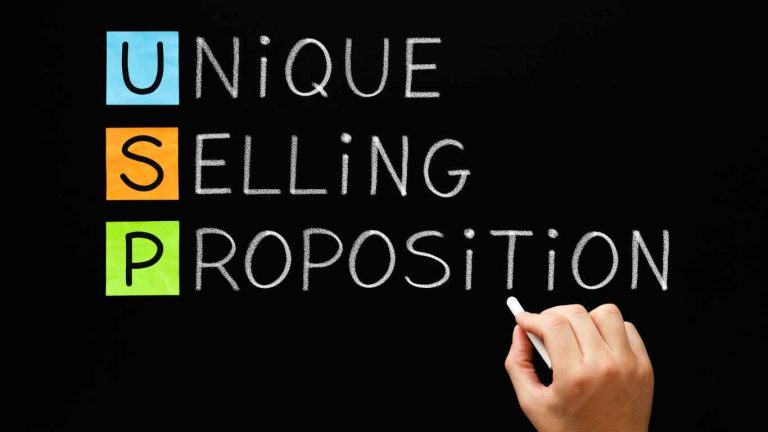Determine your unique selling proposition (USP) in your marketing plan.
In today’s crowded marketplace, standing out from the competition is more important than ever. One of the best ways to do this is to identify your unique selling proposition (USP). Your USP is what sets your products and services apart from everything else that’s available. It’s the reason customers choose your brand over your competitors. Without a clear USP, your marketing efforts can easily get lost in the noise. So, how do you go about determining the USP for your business? In this article, we’ll explore tips and strategies for identifying what makes your business unique and how to use that information to create a compelling USP that you can use in your marketing strategies and marketing campaigns with confidence.
The Origins of the Unique Selling Proposition (USP)
The concept of USP is credited to Rosser Reeves, chairman of the Ted Bates & Co. advertising agency in the 1950s. His definition of what makes a USP holds today:
- All advertising must make a proposition to the customer: Buy this, and you will receive a specified benefit.
- It must be unique; something competitors cannot claim or have not chosen to emphasise in their promotions.
- It must be so compelling that it motivates individuals to act.
In short: A USP is a tagline or memorable message that identifies the unique benefits of using your product or service instead of a competitor’s.
Strong Unique Selling Proposition
Strong USPs have the following characteristics:
- A real reason to believe that the benefits claim is credible and customers can trust the promised benefits will be delivered.
- A dramatic difference to those promised benefits makes it unique and distinguishes it from its competitors.
- Short, simple, memorable, attention-getting, persuasive, motivating, and compelling just by its wording alone.
- The USP should be an ECONOMICALLY FEASIBLE idea that can sustain a business for at least five years or more.
- It should penetrate the company, your organisation design, your systems, and your customer service, along with your marketing and communications.

Examples of Unique Selling Propositions
Domino’s became the biggest pizza brand because of its USP:
“Fresh, hot pizza delivered to your door in 30 minutes or less, guaranteed!“
So, what made Domino’s USP successful?
It answers explicitly why I should do business with them: call them if I want fresh, hot pizza delivered to my door in 30 minutes, guaranteed.
This USP is particular and meaningful. It doesn’t say, “it’ll be there soon.” Or “it will be delicious.” It says only that you will get fresh, hot pizza delivered in 30 minutes, guaranteed!
Define Your Unique Selling Proposition
A good starting point to find your unique selling proposition is to select one or two of these ten categories that all USPs fall into:
- Low Price: Guaranteeing the lowest price has been used as a USP for many online retailers. However, many who chose this USP are no longer in business. Successful implementation of this USP is Wal-Mart. “Save Money. Live Better”
- High Quality: Often used alongside “Superior Service” and “Strongest Guarantee”. Rolex is a brand that comes to mind when thinking about quality. Rolex is immediately recognisable as a high-quality timepiece and has used the USP: “Quality Takes Time.”
- Superior Service: Superior customer service is a great way to add value and develop long-term customer loyalty. Rackspace Managed Hosting has managed, in a very crowded market of “Lowest Price” competitors, to differentiate itself by focusing on giving extra mile service. Their USP statement is just two words: “Fanatical Support”
- Size/Selection: Being the “biggest” in your market or providing the largest selection of items in your niche. A classic example is Amazon.com. There were several companies selling books online before Amazon.com, so what made Amazon.com blow away other companies that entered the market sooner or had thousands of retail stores? Selection. For years Amazon’s USP was “Earth’s Biggest Bookstore
- Convenience: Centering your business around your customer’s needs. By removing as many obstacles to ordering, receiving or using your product or service as possible, you place convenience at the centre of your business model.
- Knowledgeable Advice, Recognised Authority: Works well for professionals and other skill or service-based organisations. This USP says, “I am the top in my field. You can trust my knowledge and experience.
- Customisation/Most Options: Giving your customers more options/custom building your products to their specifications works compared to your “mass market” competitors. Ping Golf Clubs was the first company to custom-fit golf clubs to each player’s swing. Ping – “The leaders in custom fit, custom built golf clubs.”
- Speed: How your product or service is delivered. FedEx revolutionised the industry when it began guaranteeing overnight delivery of packages. FedEx – “When It Absolutely Has To Be There Overnight.”
- Originality, First in Marketplace: If your product is so new and unique, then the product itself is the USP. Unfortunately, this type of USP is short-lived. Before too long, a competitor will emerge with a copy of your product
- Strongest Guarantee: Most customers assume that a company will stand behind their product or service, but an explicit, strong guarantee turns the assumed into the assured. It would be best if you made your guarantee stand out from the crowd. Craftsman tools are a prime example of this: Craftsman Tools – “Hand tools so tough, they’re guaranteed forever.” A Big, Overt Promise of BENEFITS for customers
Market Research
Invest time to complete the ActionCOACH USP survey. The survey forces you to go into detail and consider the following areas:
- Your competitors
- Your Market Place
- Positioning/your Specific Niche
- Your Customer’s Thoughts
- Your Competitive Edge

Your competitors
- Take a look at other businesses’ unique selling propositions in your industry.
- List your three biggest competitors.
Your Market Place
- Who is the average customer in your target market?
- Is the current marketplace growing or diminishing?
Positioning/your Specific Niche
- Who is your current average customer?
- What would your ideal future customer be?
- Why do your customers come to you rather than your competitors?
- What four ways do you perceive to be different from your competitors?
Your Customer’s Thoughts
- What things would your best and your worst customers say about you?
- How is your business (and you) better and different than your competitors?
Your Competitive Edge
- Look at it from your customer’s viewpoint:
- Are there ways you give better service than others?
- Are you more experienced in certain areas?
- Are you more personal?
- Do you have better guarantees or better payment options?
- Do you have better equipment?

Defining Your USP
In my experience, once you have completed the USP survey, conducted market research by surveying your customers, and selected from the ten categories, you can brainstorm possible succinct USP statements.
Then select one and experiment using it on your website and digital marketing assets. These can easily be changed.
When you are comfortable with your USP statement, commit to using it in all your marketing collateral.
Remember, your USP is not fixed (unlike your Purpose or Culture). It would be best if you looked to achieve at least five years before needing to change your USP.
Systemetising Your Business
Your systems must deliver the promises that you are claiming in your USP. In the example of Domino’s pizza, their entire organisation had to be designed to meet the 30-minute door-to-door delivery expectation given their guarantee. Your systems must live up to your marketing promises in your USP.
Conclusion
In today’s crowded marketplace, standing out from the competition is more important than ever.
A USP is a tagline or memorable message that identifies the unique benefits of using your product or service instead of a competitor’s.
A good starting point to find your unique selling proposition is to select one or two of these ten categories: Low Price, High Quality, Superior Service, Size/Selection, Convenience, Knowledgeable Advice/ Recognised Authority, Customisation, Speed, Being First to market and Strongest Guarantee.
Invest time to complete the ActionCOACH USP survey. The survey forces you to go into detail and consider your competitors, your marketplace, positioning your specific niche, your customer’s thoughts, and your competitive edge.
You can then brainstorm possible succinct USP statements. Then select one and experiment using it on your website and digital marketing assets. When you are comfortable with your USP statement, commit to using it in all your marketing collateral.
Your USP should penetrate the business, your organisation design, your systems, and your customer service, along with your marketing and communications.
By Natalie Simms

